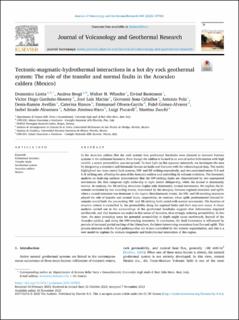| dc.contributor.author | Liotta, Domenico | |
| dc.contributor.author | Brogi, Andrea | |
| dc.contributor.author | Wheeler, Walter H | |
| dc.contributor.author | Bastesen, Eivind | |
| dc.contributor.author | Garduño-Monroy, Victor Hugo | |
| dc.contributor.author | Macias, José Luis | |
| dc.contributor.author | Sosa-Ceballos, Giovanni | |
| dc.contributor.author | Pola, Antonio | |
| dc.contributor.author | Avellán, Denis-Ramón | |
| dc.contributor.author | Bianco, Caterina | |
| dc.contributor.author | Olvera-García, Emmanuel | |
| dc.contributor.author | Gómez-Alvarez, Fidel | |
| dc.contributor.author | Israde-Alcantara, Isabel | |
| dc.contributor.author | Jiménez-Haro, Adrian | |
| dc.contributor.author | Piccardi, Luigi | |
| dc.contributor.author | Zucchi, Martina | |
| dc.date.accessioned | 2023-12-13T08:12:58Z | |
| dc.date.available | 2023-12-13T08:12:58Z | |
| dc.date.created | 2023-12-11T13:46:52Z | |
| dc.date.issued | 2023 | |
| dc.identifier.citation | Journal of Volcanology and Geothermal Research. 2023, 444 . | en_US |
| dc.identifier.issn | 0377-0273 | |
| dc.identifier.uri | https://hdl.handle.net/11250/3107256 | |
| dc.description.abstract | In the Acoculco caldera (hot dry rock system) two geothermal boreholes were planned to intersect fracture systems in the carbonate basement. Even though the caldera is located in an area of active deformation with high rainfall, a scarce permeability was recognized. To shed light on this apparent mismatch, we investigate the area by integrating a structural and kinematic dataset on faults and fractures with the volcanological data. The results highlighted two main coeval fault systems, NW- and NE striking respectively, and two associated minor N-S and E-W striking sets, affecting the area of the Acoculco caldera and controlling its volcanic evolution. The kinematic analysis on fault-slip surfaces demonstrated that the NW-striking faults are characterized by two superposed movements: the first comprises right strike-slip to right lateral oblique-slip, while the second is dominantly normal. In contrast, the NE-striking structures display only dominantly normal movements. We explain the kinematic evolution by two recurring events, determined by the interplay between regional extension and uplift: when a crustal extension was dominant in the region (first kinematic event), the NW- and NE-trending structures played the role of transfer and normal faults, respectively; in contrast, when uplift predominated (second kinematic event) both the pre-existing NW- and NE-striking faults acted with normal movements. The location of eruptive centers is controlled by the permeability along the regional faults and their step-over zones. A closer analysis carried out in the surroundings of the geothermal boreholes suggests that deformation migrated northwards, and that fractures are sealed in this sector of Acoculco, thus strongly reducing permeability. In this view, the most promising areas for potential permeability at depth might occur northwards, beyond of the Acoculco caldera, and along the NW-trending structures. In conclusion, the fault kinematics is influenced by periods of increased partial melting of the lithosphere, the latter determining anomalous heat flux and uplift. This process interacts with the fluid pathways that are in turn controlled by the tectonic segmentation, and this is a new model to explain the tectonic-magmatic and hydrothermal interaction of this region. | en_US |
| dc.language.iso | eng | en_US |
| dc.rights | Navngivelse 4.0 Internasjonal | * |
| dc.rights.uri | http://creativecommons.org/licenses/by/4.0/deed.no | * |
| dc.title | Tectonic-magmatic-hydrothermal interactions in a hot dry rock geothermal system: The role of the transfer and normal faults in the Acoculco caldera (Mexico) | en_US |
| dc.title.alternative | Tectonic-magmatic-hydrothermal interactions in a hot dry rock geothermal system: The role of the transfer and normal faults in the Acoculco caldera (Mexico) | en_US |
| dc.type | Peer reviewed | en_US |
| dc.type | Journal article | en_US |
| dc.rights.holder | © 2023 The Authors | en_US |
| dc.description.version | publishedVersion | en_US |
| cristin.ispublished | true | |
| cristin.fulltext | original | |
| cristin.qualitycode | 1 | |
| dc.identifier.doi | 10.1016/j.jvolgeores.2023.107963 | |
| dc.identifier.cristin | 2211774 | |
| dc.source.journal | Journal of Volcanology and Geothermal Research | en_US |
| dc.source.volume | 444 | en_US |
| dc.source.pagenumber | 20 | en_US |

